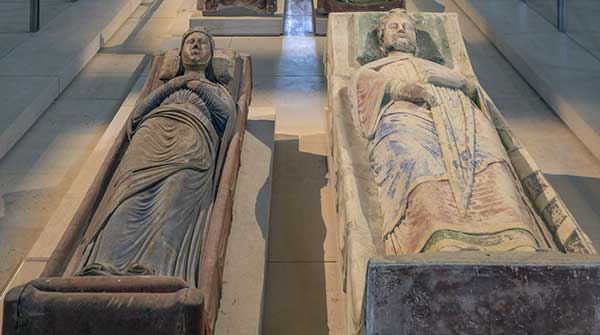England’s most famous medieval king was, like his parents, more French than English
 On April 6, 1199 – five days before Palm Sunday – Richard the Lionheart died as a result of an infected shoulder wound sustained during a castle siege in one of his French dominions. Known to history as England’s most famous medieval king, Richard was much more than that.
On April 6, 1199 – five days before Palm Sunday – Richard the Lionheart died as a result of an infected shoulder wound sustained during a castle siege in one of his French dominions. Known to history as England’s most famous medieval king, Richard was much more than that.
In a culture that esteemed military prowess, he was the foremost European warrior of his age. And he ruled a swathe of territories bequeathed by his father (Henry II). Its scope was vast, stretching from the Scottish border to the Pyrenees and embracing much of modern France.
Because Henry’s ancestral home was the small French county of Anjou, historians have described this territorial agglomeration as the Angevin Empire. Truth be told, the empire had a makeshift quality, Henry having pieced it together via a fortuitous combination of inheritance and marriage.
|
|
| Related Stories |
| Was Richard the Lionheart gay?
|
| If you like medieval drama, The Last Kingdom fits the bill
|
| England’s warrior queen
|
Anjou and Normandy came first, as Henry inherited them from his parents. Then marriage to Eleanor of Aquitaine brought her duchy into the fold. Finally, when the English throne became vacant in 1154, Henry’s maternal connection to a prior monarch was sufficient to do the trick.
Unwieldy though it may have been, the Angevin Empire thus became a real thing.
Henry and Eleanor’s marriage produced no fewer than eight children but became so turbulent and embittered that she encouraged their sons to revolt. For this, Henry had her confined, only to be temporarily released on special occasions like Christmas.
And Richard, on whom Eleanor doted, was a particularly persistent rebel. Nonetheless and however reluctantly, the dying Henry had little option but to recognize Richard as heir in 1189.
Most modern academic treatments of Richard tend to take a distinctly unfavourable view. Dismissing his unquestioned military prowess as unsavoury and irrelevant, the focus tends to be on his alleged neglect of England. Historian Sir Steven Runciman captured the conventional wisdom most acutely, characterizing Richard as “a bad son, a bad husband and a bad king.”
But whatever the merits of the first two criticisms, the “bad king” rap suffers from a conceptual flaw. Rather than evaluating Richard in terms of who he was and the world in which he lived, it insists on seeing him as, first and foremost, an English king. That’s a misapprehension.
Although born in Oxford, Richard wasn’t English in any meaningful sense. And England was neither the most important part of his empire nor the most in need of protection and attention. That designation belonged to his rich French dominions, which were constantly under threat from the machinations of the French king, Philip Augustus.
Like his parents, Richard was culturally and ethnically French. Describing just who he was, French historian Jean Flori cuts to the chase: “As for Richard, in daily life he spoke the northern French of his father, and read and wrote the langue d’oc of his mother, but his Latin seems to have been limited and his English non-existent … King of England and emblematic image in his country, Richard was in no way an English king.”
While he was a larger-than-life figure, the circumstances of Richard’s demise were small.
After supper on the evening of March 26, 1199, he went to check the progress of an ongoing castle siege in a rebellious part of Aquitaine. And because he wasn’t going into battle, he didn’t bother with body armour, which rendered him vulnerable to a lucky crossbow bolt fired from the castle wall. It lodged in his left shoulder.
Back in the royal tent, a surgeon working by flaming torchlight eventually dug out the offending barb and the wound was dressed and bandaged. However, as medieval European surgery wasn’t big on infection control, gangrene quickly set in. Richard’s luck had run out.
The process of dying wasn’t quick – he lingered for 11 days before expiring in the evening of April 6. But Richard had seen enough death to know what was happening, so he went about putting his political and spiritual affairs in order.
He also sent for the one person he cherished most – his mother. Now in her late 70s and living at Fontevraud in Anjou, Eleanor hurried to her favourite child’s deathbed, reputedly arriving shortly before the end.
Perhaps the clearest statement of how Richard saw himself can be gleaned from the instructions he gave for the disposition of his physical remains. His entrails were lodged in Aquitaine, his heart went to Rouen in Normandy, and the rest of his body was buried in Anjou’s Fontevraud Abbey.
No part of him was sent “home” to England, because England wasn’t home.
Troy Media columnist Pat Murphy casts a history buff’s eye at the goings-on in our world. Never cynical – well, perhaps a little bit.
For interview requests, click here.
The opinions expressed by our columnists and contributors are theirs alone and do not inherently or expressly reflect the views of our publication.
© Troy Media
Troy Media is an editorial content provider to media outlets and its own hosted community news outlets across Canada.

